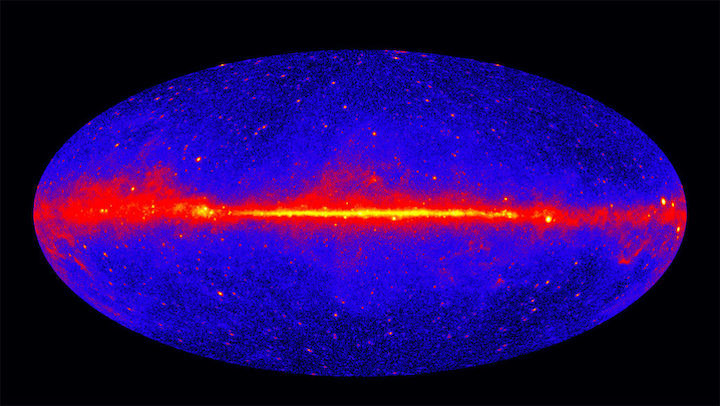24.03.2020

In this image from the Fermi space telescope, the Milky Way's stellar disk, which runs horizontally along the middle, glows in gamma rays. A vast halo of dark matter engulfs the disk and emits no light at all, which makes measuring the galaxy’s total size a challenge.
FERMI LAT COLLABORATION/DOE/NASA
Our galaxy is a whole lot bigger than it looks. New work finds that the Milky Way stretches nearly 2 million light-years across, more than 15 times wider than its luminous spiral disk. The number could lead to a better estimate of how massive the galaxy is and how many other galaxies orbit it.
Astronomers have long known that the brightest part of the Milky Way, the pancake-shaped disk of stars that houses the sun, is some 120,000 light-years across (SN: 8/1/19). Beyond this stellar disk is a disk of gas. A vast halo of dark matter, presumably full of invisible particles, engulfs both disks and stretches far beyond them (SN: 10/25/16). But because the dark halo emits no light, its diameter is hard to measure.
Now, Alis Deason, an astrophysicist at Durham University in England, and her colleagues have used nearby galaxies to locate the Milky Way’s edge. The precise diameter is 1.9 million light-years, give or take 0.4 million light-years, the team reports February 21 in a paper posted at arXiv.org.
To put that size into perspective, imagine a map in which the distance between the sun and the Earth is just one inch. If the Milky Way’s heart were at the center of the Earth, the galaxy’s edge would be four times farther away than the moon actually is.
To find the Milky Way’s edge, Deason’s team conducted computer simulations of how giant galaxies like the Milky Way form. In particular, the scientists sought cases where two giant galaxies arose side by side, like the Milky Way and Andromeda, our nearest giant neighbor, because each galaxy’s gravity tugs on the other (SN: 5/12/15). The simulations showed that just beyond the edge of a giant galaxy’s dark halo, the velocities of small nearby galaxies drop sharply (SN: 3/11/15).
Using existing telescope observations, Deason and her colleagues found a similar plunge in the speeds of small galaxies near the Milky Way. This occurred at a distance of about 950,000 light-years from the Milky Way’s center, marking the galaxy’s edge, the scientists say. The edge is 35 times farther from the galactic center than the sun is.
Although dark matter makes up most of the Milky Way’s mass, the simulations reveal that stars should also exist at these far-out distances. “Both have a well-defined edge,” Deason says. “The edge of the stars is very sharp, almost like the stars just stop at a particular radius.”
In the future, astronomers can refine the location of the Milky Way’s edge by discovering additional small galaxies nearby. Astronomers could also search for individual stars out at the boundary, says Mike Boylan-Kolchin, an astrophysicist at the University of Texas at Austin who was not involved with the study. The farthest such stars will be very dim, but future observations should be able to find them.
The measurement should also help astronomers tease out other galactic properties. For instance, the larger the Milky Way, the more massive it is — and the more galaxies there should be revolving around it, says Rosemary Wyse, an astronomer at Johns Hopkins University who was not part of the new work. So far, there are about 60 known Milky Way satellites, but astronomers suspect that many more await discovery.
Quelle: ScienceNews
